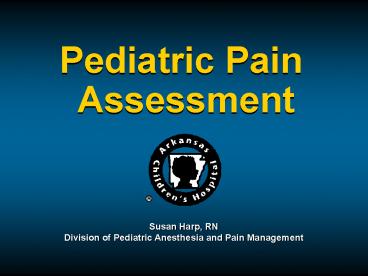Pediatric Pain - PowerPoint PPT Presentation
1 / 37
Title:
Pediatric Pain
Description:
Pediatric Pain Assessment Pediatric Pain Assessment Susan Harp, RN Division of Pediatric Anesthesia and Pain Management Pain Assessment Location Characteristics Onset ... – PowerPoint PPT presentation
Number of Views:356
Avg rating:3.0/5.0
Title: Pediatric Pain
1
Pediatric Pain Assessment
Pediatric Pain Assessment
Susan Harp, RN Division of Pediatric Anesthesia
and Pain Management
2
Goals of Pain Assessment
Provide accurate information to determine
which actions could be taken to alleviate the
pain, and, on an ongoing basis evaluate the
effectiveness of these actions. Judith
Beyer and Nancy Wells, PEDIATRIC CLINICS OF
NORTH AMERICA,1989
3
Pain Assessment
- Location
- Characteristics
- Onset / Duration
- Frequency
- Quality
- Intensity / Severity
- Precipitating Factors
4
Assessment Tools
- Self-Report The Gold Standard
- Observational Scales
- Physiologic Parameters
- Parent Report
- Nurse Report
5
Self-Report
- Description of Pain- type of pain- intensity of
pain - Pain Scale Ratings
6
Observations
- Vocalization / verbalization
- Facial Expression
- Body Language
- Emotional State
7
Physiologic Parameters
- Heart rate
- Respiratory rate
- Blood pressure
8
(No Transcript)
9
Parent Vs. Nurse Report
- Varying results in studies comparing parent,
nurse, and self-report - May be especially useful in cognitively impaired
children
10
Special Situations
- Cognitively impaired
- Cerebral palsy with normal cognitive level
- Hearing or vision impaired
- Non-English speaking
- Intubated / paralyzed patients
11
Developmental Factors
- Newborns and small children unable to give
self-report - However, avoidance behavior has been shown by at
least 6 months of age - Consistency of facial and cry response has been
shown in neonates and infants - Children 3-5 yrs are able to use some self-report
measures, localize pain
12
Assessment in Neonates
- Neonatal Infant Pain Scale (NIPS)
- Objective Pain Scale (OPS)
- Cries
- Parent Report
- Nurse Report
- Physiologic Measures
13
Neonatal Infant Pain Scale (NIPS)
- Facial Expression - relaxed, grimace
- Cry - no cry, whimper, vigorous
- Breathing patterns - relaxed, changed
- Arms - relaxed, flexed/extended
- Legs - relaxed, flexed/extended
- State of Arousal - sleeping/awake, fussy
Lawrence J, et. al
14
Objective Pain Scale (OPS)
- Blood pressure - 10, 10-20, 20-30 preop
- Crying - not crying, crying /- response to TLC
- Moving - none, restless, thrashing
- Agitation - calm, mild, hysterical
Broadman LH, Hannalah RS, et.al
15
Objective Pain Scale (OPS)
- Verbal Eval / Body Language- asleep/states no
pain- mild pain (cannot localize)- moderate
pain (localizes)
Broadman LH, Hannalah RS, et.al
16
Assessment in Infants and Children lt 3 Years
- OPS
- CHEOPS
- Parent Report
- Nurse Report
- Physiologic Measures
17
Childrens Hospital of Eastern Ontario Pain Scale
(CHEOPS)
- Cry - None, Moaning, Crying, Screaming
- Facial - Composed, Grimace, Smiling
- Verbal - None, Other, Pain, Both, Positive
- Torso - Neutral, Shifting, Tense,
Shivering, Upright, Restrained - Touch - None, Reach, Touch, Grab, Restrained
- Legs - Neutral, Squirming, Drawn-up, Standing,
Restrained
18
Assessment in Children 3-6 Yrs
- Faces Scale
- Oucher Scale
- Poker Chip Tool
- Visual Analogue Scale (VAS)
- Observation Tools
- Parent Report
- Nurse Report
19
FACES Rating Scale
Adapted from Wong/Baker FACES Rating Scales Wong,
D and Whaley, L Clinical Handbook of Pediatric
Nursing ed.2, p. 373, St. Louis, 1986, The C.V.
Mosby Company.
20
OUCHER!
21
(No Transcript)
22
Numerical Rating Scale
23
Assessment in Children gt 6-7 Yrs
- Self-Report- VAS- Numerical Ranking Scale
- Observational Scales
- Parent Report
- Nurse Report
24
(No Transcript)
25
Golden Rule of Pain Assessment
- Dont forget to ask the patient !!!
26
Pain Assessment in Children
Pain is whatever the patient says it is.
27
Facts About Children Pain
- Infants do feel pain
- Children do not tolerate pain better than adults
- Children can tell you where they hurt
- Children do not always tell The truth about pain
28
Facts About Children Pain
- Children do not become accustomed to pain or
painful procedures - Behavioral manifestations of pain may not reflect
pain intensity - Narcotics are no more dangerous for children
than adults
29
(No Transcript)
30
(No Transcript)
31
(No Transcript)
32
(No Transcript)
33
(No Transcript)
34
(No Transcript)
35
(No Transcript)
36
(No Transcript)
37
(No Transcript)































